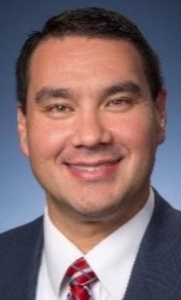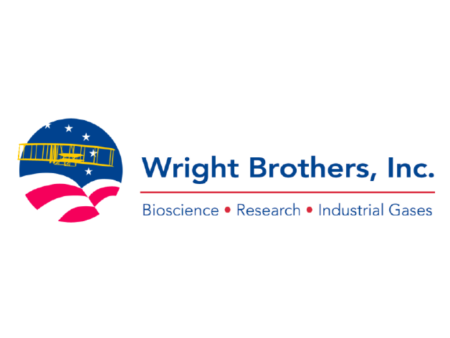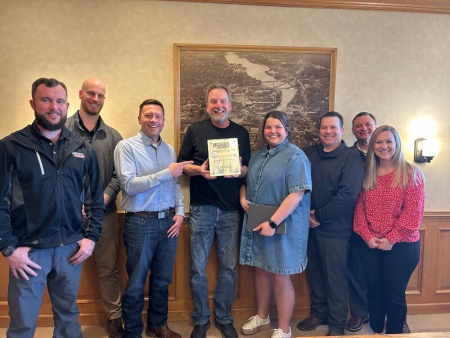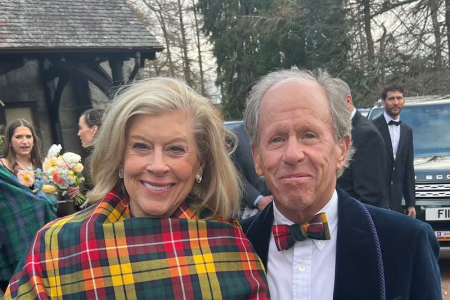On March 27, 2020, the American Welding Society’s (AWS) Board of Directors announced Gary Konarska II as the organization’s new Executive Director and CEO. Konarska succeeded Ray Shook, who held the position for 15 years and who agreed to remain as Executive Director Emeritus for an interim period to ensure a seamless and successful transition.

Konarska brings 20 years of experience in the welding and cutting equipment industry, where he worked with Lincoln Electric Holdings, Inc., of Cleveland, Ohio. Most recently, Konarska served as Vice President, Global Automation, where he was responsible for 13 automation sites around the world and created business systems to drive metrics and continuous improvement. Throughout his tenure at Lincoln, he focused on international business and sales, strategic planning, and fostered collaboration and relationships among teams. Konarska spent time living and working in Singapore with The Lincoln Electric Company (Asia Pacific) PTE Ltd., as Managing Director for Southeast Asia, South Korea, and Taiwan. He was responsible for all commercial activities in the region, as well as a welding consumable manufacturing plant in Indonesia. Prior to this role, he was based in Shanghai, China, as Director of Business Development, where he led core business functions including export and import sales, a robotic automation P&L, product management, marketing communications, service, and a welding technology center. He started his career as a Technical Sales Representative in Seattle, WA, and then Tampa, FL.
Gary sat down with Welding & Gases Today to discuss this new role.
Welding & Gases Today: What are you most excited about taking over this role?
Gary Konarska: I would say the opportunity to really be the advocate for the entire welding industry. To have the opportunity to talk about welding to all constituents of welding. When you’re working for one of the manufacturers, you always tend to have a slant in all of your conversations. Now, I have the opportunity to look at things holistically without a particular slant and really try to be neutral as we approach the development of new programs, training of our workforce, and how we engage in support of that. That was the draw, for me, to this job. To have a bigger voice in and around the welding community.
WGT: Having spent your career at Lincoln prior to this, is there any concern about your ability to be impartial now that you’re an advocate for the entire industry?
GK: That was actually one of the interview questions. Because I spent ten years outside of the U.S., my view of the welding world is a lot different and broader because of this experience. In Asia, which is where I was stationed, Lincoln was not the market leader. There were other competitors that were really the “name brands.” There were times when people didn’t even fully understand what the full Lincoln portfolio was. So, while they are a market leader here in the U.S., I spent a decade in a place where there were times people didn’t even know that Lincoln made MIG machines. So, I’ve got a different kind of view of the industry, I think, which will give me a more objective approach, just because of that experience that I had.
WGT: You mentioned how your experience in Asia brought some things to light with regards to Lincoln, but is there anything about the Asian market and the way that they do things that gives you a different perspective to bring back to the U.S.?
GK: I could probably highlight a few different things. More than half of the world’s welding is happening in the Asian marketplace. I think it’s up over 60%, even. I think that is a realization that it is an important part of the global welding community. One of the other things that people may not understand is that they do quite a bit of automation in those markets. In China, they are today consuming more than 50% of the robot arms on the planet. You wouldn’t typically think that, because they have ample supply of human resources, but they face the same challenges that any market does. The issue of people entering the welding world as a welder. They have that same challenge. The skilled labor is not readily available, necessarily. They’re the largest ship building country today. They have automated like crazy over the last two decades. So, their facilities are pretty modern because the industry is relatively new versus some of the other markets in the world.
I would also say that people’s approach to job roles and responsibilities is different. In the U.S. or Australia, there is more of a “do-it-yourself mentality.” Even executives of a company might go change their oil on a Saturday. That is not as common in Asia. People tend to focus on what they were trained or studied to do. If they aren’t a mechanic, they probably don’t work on their car. So, in the welding world, for a welding engineer, there isn’t a practical component to what they do. Whereas, maybe here in the U.S., there is. A welding inspector, who once upon a time might have been a welder, can grow into being a welding inspector. That kind of professional growth is a little bit different in a lot of the Asian communities.
WGT: You mentioned the dearth of skilled labor, it sounds like that isn’t an isolated U.S. issue. AWS has always done a great job of advocating for the industry as a viable, rewarding skill path. What are some of the steps that you will take to continue to build the population of welders and continue to show that this is a viable career?
GK: That’s where the AWS Foundation focuses a lot of their energy. Entrance into the welding world. We’re going to continue to expand on the careers in welding platform. That has been out there for some time to promote welding as a career. And bringing the technology component to what is happening in welding today. If you talk to most welding power source manufacturers, as an example, they’re all digitally communicating between their different components. People don’t think that there is this technology component to how the industry is evolving. We’ve got to bring that into the purview of a young, impressionable high school student trying to figure out what they’re going to do with their life. They’ve grown up with technology all around them, had a phone since they were 12 years old. Look at welding machines today: Graphical User Interfaces, touch screens, LED panels, etc. The welding machines hook up to laptops so you can analyze what you’re doing. We’ve got to continue to demonstrate that this isn’t this old, traditional industry that people may talk about. It is progressive.
Where does automation fit? Historically, there has been this concern about automation taking jobs. We’ve been evangelizing, at AWS, for a long time, about this skills gap and the shortage of welders that exists. And it will continue to get worse as we go into 2023-2025. When you look at automation, we know there is going to be an availability of welders and a need for welding, and there is a gap there. That’s where I think automation can bridge that gap. It will redeploy some welders to do more complex roles and the robot can take over the more repetitive jobs. But I don’t see it displacing welders. There is too much of a shortage, overall, within the industry, for it to displace all welders. That will be something that we start discussing more.
I spent my last three years in the automation space, running integration. In my last year, I was responsible for 13 different integration sites. That was part of our conversation. I don’t know of any robot that we sold that replaced anybody. There were many times where it was because they couldn’t keep somebody. When you’re in a remote area, where there’s not a skilled talent pool and you can’t keep a welder, those companies do it because they have to. The first choice of a welder is not available. There are lots of examples of companies that just can’t get qualified welders to do what they need. And that comes back to schools, improving their vocational aspects, so that there is that skilled welding pool coming into the community.
WGT: Coming to AWS from the industry, you’ve seen first-hand the importance of AWS in our industry. Could you expand on that?
GK: As I learn more about what the roles of different associations play within the industries that they’re supporting, one thing that AWS really brings is their long established and strong standardization program, industry standards and certification to a third-party type of standard. That’s something that is actually not as common among associations. AWS has established and distinguished itself in that regard. There is a guiding way that the manufacturers can all classify their products to a certain standard and those standards have been developed in a very objective and collaborative way. The committees are actually people from industry. They’re not employees of AWS. They’re the ones utilizing the products and manufacturing the products. They work together to reach a consensus to put that in place. So, I think that’s probably one of the most important aspects of what AWS has traditionally done. And the continued advocacy for welding. To help to bring welders into the community. That’s important. And I think that’s a role that we have to continue to play, to increase our influence and our advocacy for welding careers and welding professionals, because who else is going to do it? With the footprint that we’ve got and the voice that we have, that’s one of our obligations and fulfills our mission.
WGT: You’re taking over as the AWS enters its second century of existence. What does that mean to you, personally, to be taking over at such a watershed moment for AWS?
GK: You don’t get to be 100 years strong without having lots of traditions. I have to really make sure that I honor those that have gotten us to where we are. But, at the same time, you also have to evolve as an organization. We have to continue to look at the digital tools available and how we can continue to broaden our offerings to the welding community in an online platform. With 100 years, you can’t discount all of the great things that have happened, we have to use those as the foundation to evolve into how the world thinks and works today. How do we continue to attract those people and ideas into the industry? Because how we attracted them 30 years ago is not how we will attract them today. So, I would say honor the tradition but use it as a foundation for growth and evolution.
WGT: You talk about the industry evolving and attracting new communities, I know Lincoln and AWS were very involved with Jessi Combs and the Women in Welding initiative.
GK: If you look at traditions, I’ve heard the term, “old boys club.” A lot of skilled trades were male dominated for many years. Our industry has really evolved. Today, we are supporting Women in Welding. That’s a moniker that is often used. Beyond that, whether it’s race, religion or any other diverse group of individuals, we really need to be serving everybody. Our Diversity, Equity, and Inclusion Committee within AWS leads our initiatives to serve the whole of the industry. So, AWS recognizes that this is an area where we need to continue to reach out to women and other underrepresented groups, so that we’re really targeting the entire community of potential welders out there. We see that in a lot of aspects of our life. Some of those stigmas are, albeit slowly, breaking free from what traditional gender roles are. Women are great welders. I remember 20 years ago, when I was going through welding school, there were four women in our sales development training class. One of the instructors highlighted that, because they have more dexterity in their hands, when it comes to welding they actually have a very steady hand to do it. And you do see more and more women in the industry. But it’s still a pretty low percentage of the whole.
WGT: We talked about how exciting it was for you to be taking over just after the association celebrated its 100-year anniversary. On the flip side, you’re also taking over at a pretty stressful time in our country and our economy, in the middle of a global pandemic. Have you given any thought to the types of challenges that that will present?
GK: We have been talking about that. There are a couple of areas that we’ve been discussing. One is at the welding schools and the educational facilities, what are some of the guidelines that everybody should implement to ensure that they have the proper social distancing and the right tools in place to practice good personal hygiene? When you’re welding, you don’t always wash your hands all the time. But, at the same time, you now have to think about these things. So, we are looking into what we can do to provide some guidance around the restarting of welding schools. I think, in the end, there is a lot of guidance out in the market today. Internally, ourselves, in Miami, we have a pretty decent sized staff, about 130 employees. Right now, we’ve only got a dozen people working in the building. Everybody else is telecommuting. We’ve devised a phased plan to return to our offices. So, if we can communicate some of the things that we’re doing, ourselves, I think that can be part of it as well. We’re practicing social distancing and wearing facial coverings in the office. I recorded a video to our staff detailing what we did when Ray Shook and I met. We stood at opposite ends of a table and wore facial coverings in that meeting for four hours. We took every proper precaution that we could. We want to make sure we’re leading by example. And be open about it. When people are reaching out for advice, we make sure to tell them that we’re not health experts, but we can tell them all of the precautions that we’re taking to ensure a safe operation.
It’s funny, you go into a new role and your first thought is, “I want to meet the team and start the learning curve so that I can actually start delivering.” Those fell to second and third on the priority list because on day one it was crisis leadership as we were sheltering in place. Immediately, I started engaging the broad organization. That has been a unique aspect of the role, having to step in and be a leader in crisis on day one.
WGT: If you want to look at it as the glass is half full, you probably are not going to have to deal with something worse than this during your tenure, so you got it out of the way early.
GK: There you go. Always find that silver lining.
WGT: Is there anything that you want our readers to know about you as you step into this position?
GK: I would say that I’ve got a unique background of understanding the welding industry. I had the fortunate opportunity to work in five different geographic locations, in very diverse roles. And, even within those roles, I dealt with a lot of different corners of the welding industry. And, in particular for your readership, I worked very heavily with welding distribution during my years when I was stationed in Florida. It’s a market that is very heavily reliant upon the welding distribution channel. So, I feel like I have a pretty good understanding of some of the challenges that they face because of that experience. And then, I worked with international distribution as well, where they were our only channel to market in some places. So, I worked closely with distribution for my entire career. I have a pretty good understanding of some of those pain points. But I don’t have a full understanding. So that is one of the things I do want to learn. The welding distribution portion of the welding industry is absolutely critical. Without them, the welding industry wouldn’t exist. They’re critical for delivery of that final mile within the supply chain. I would like to fully understand what we, as the welding society, can do to support where they see pain. Their lens is going to be different than a fabricator or a manufacturer, but they’re still a very important constituent within the welding industry.
WGT: How do you feel that AWS and GAWDA can work together to best promote this industry?
GK: I think there are complementary initiatives that are core to the mission of GAWDA and the mission of AWS. I know there has been a very close tie between AWS and GAWDA for many years. That’s one of those traditions that I plan to build upon, not break down. When I look at the different parts of what makes up our welding ecosystem, distribution plays a critical role in that ecosystem, and we need to make sure that they have a voice in how the industry is managed, ultimately.








